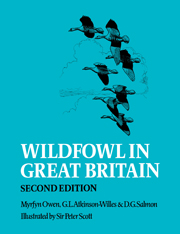Book contents
- Frontmatter
- Contents
- List of location maps
- Foreword by William Wilkinson
- Acknowledgements
- Conventions and abbreviations
- Part I Introduction
- Introduction to the survey
- Wildfowl Counts
- Wildfowl ringing
- Information from shot birds
- Part II The survey of wildfowl habitat and distribution
- Part III Species accounts
- Part IV The conservation of wildfowl and their habitats
- Conclusion
- References
- Indexes
Wildfowl ringing
Published online by Cambridge University Press: 04 August 2010
- Frontmatter
- Contents
- List of location maps
- Foreword by William Wilkinson
- Acknowledgements
- Conventions and abbreviations
- Part I Introduction
- Introduction to the survey
- Wildfowl Counts
- Wildfowl ringing
- Information from shot birds
- Part II The survey of wildfowl habitat and distribution
- Part III Species accounts
- Part IV The conservation of wildfowl and their habitats
- Conclusion
- References
- Indexes
Summary
Knowledge of the origins and movements of wildfowl is essential if they are to be effectively managed or conserved. The Wildfowl Inquiry Committee was initially responsible for coordinating and stimulating efforts (591). By 1937 the ringing scheme had been transferred to the management of the BTO and all subsequent rings bore the address of the British Museum (Natural History).
The Wildfowl Trust was making a substantial contribution to the ringing effort soon after its establishment in 1946, and in 1954 responsibility for wildfowl ringing was transferred from the Wildfowl Inquiry Committee to the Trust. Table 1 gives the number of wildfowl ringed by the Trust and in Britain as a whole, to the end of 1981. Apart from the Mute Swan, the subject of a large number of local population studies, the Trust has been responsible for the vast majority of geese and swans ringed. Expeditions to the Arctic breeding grounds of Barnacle and Pink-footed Geese have added considerably to the total ringed by the Wildfowl Trust. The majority of ringed ducks have been marked at the Trust's trapping stations, but a few species have been the subject of special studies elsewhere. For example, most of the Eiders and many of the Shelducks have been marked in connection with population studies on the Ythan Estuary, Aberdeen, and the Goosanders have largely been caught by a ringing group in Northumberland (337).
The majority of marked birds have been ringed in the last two decades, largely as a result of new trapping stations coming into operation and new methods of catching yielding greater numbers of certain species.
- Type
- Chapter
- Information
- Wildfowl in Great Britain , pp. 7 - 19Publisher: Cambridge University PressPrint publication year: 1986

